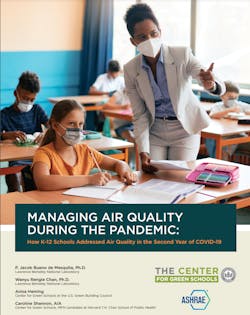Inside Maintenance & Operations: Improving Indoor Air
To improve indoor air quality (IAQ) and combat the spread of Covid-19, schools have prioritized increasing outdoor air intake, the Center for Green Schools says in a new report.
The report, “Managing Air Quality During the Pandemic: How K-12 Schools Addressed Air Quality in the Second Year of Covid-19,” surveyed districts from October through December 2021 and found that increasing outdoor air through HVAC systems was the most prevalent building engineering control measure carried out by schools. Opening windows in school facilities was the next most common step.
However, many schools also reported that their efforts to adopt some of the recommendations for improving IAQ were stymied because their HVAC systems were not designed to enable greater outdoor air flow.
“The results highlight the urgent need to better support school districts with implementation of airborne infection control strategies to mitigate the immediate Covid-19 threat, as well as future pandemics, seasonal epidemics, and to improve the overall indoor air quality in the near- and long-term,” the report says.
The Center for Green Schools survey, conducted with technical support from ASHRAE, is a follow-up to a 2021 report from the Center. The latest survey received responses from 88 districts representing over 4,000 schools and over 2.6 million students.
“There is a great deal of opportunity to improve IAQ in schools though more widespread implementation of HVAC ventilation and filtration, operable windows and germicidal UV,” the report says.
Survey respondents said their efforts to take proper steps to improve air quality and ward off spread of Covid-19 was made more difficult by a flurry of information, quickly changing and sometimes contradictory, about the best measures to adopt.
“The confusion caused by the need to sort through a lot of rapidly changing information related to which Covid-19 controls to prioritize—and a barrage of marketing for air cleaning devices—to make decisions that can be accepted by the broader community was a common theme that emerged in focus groups,” the report says.
The survey also found that schools have been carrying out steps to improve IAQ with federal Covid relief funding rather than capital or operating funds. That raises the question of whether schools will be able to continue those initiatives once Covid relief funds dry up.
“Overall, only 54% of districts responded that they have access to funding to implement additional ventilation and filtration strategies or to make other building changes in schools,” the report says; “23% responded that they do not, and 24% responded that they were unsure. Considering that at least 36,000 of the nation’s 100,000 public schools are likely in need of HVAC system updates or replacement, the lack of capacity to implement additional measures is concerning.”
The Center says that schools need to be give clear guidance so that they have the flexibility to use different strategies to improve IAQ depending on the varied characteristics and conditions found in specific school buildings.
“Communication to these districts with a variety of building challenges is important to ensure an understanding that multiple strategies can be deployed in different schools to achieve a similar level of air cleaning,” the report says. “There does not need to be a single approach selected.”
To further the discussion on how schools can address the need for better IAQ, the Center put forth these recommendations.
• Conduct a cost-benefit analysis that examines capital and operational expenses and weighs them against the health, healthcare, economic, and cognitive benefits of improved air quality. “Guidance from this analysis will especially impact decision-makers in school districts with disparate buildings and equipment who may be uncertain if changes like filter upgrades should be done in part or across the district,” the report says.
•Conduct studies to evaluate the effectiveness and the combined effects of different building controls. This should include studies of technologies that districts are less familiar with but are recommended by federal agencies like the CDC, such as upper room germicidal ultraviolet light (GUV).
• Carry out a study of climate-specific best practices to better inform IAQ strategies in different regions of the United States. “This study should include considerations such as heat and humidity, as well as susceptibility to factors like wildfires or air pollution,” the report says.
• Develop more informed decision-making strategies regarding how to balance the need for improving IAQ and concerning about increasing energy consumption and costs. “Tradeoffs, efficiencies, control measure effectiveness, sustainability goals, and budgetary concerns all contribute to analyzing these opposing considerations,” the Center says.
